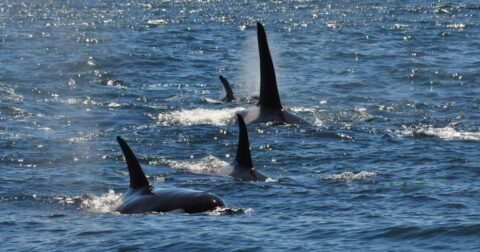Is New York City Getting its Composting Program Right?
Climate•10 min read
Explainer
Commercial fishing threatens marine life — and it seems orcas are trying to do something about it.


Words by Björn Ólafsson
Orcas are attacking fishing vessels in moves that some people online are calling “orcanizing.” We know that orcas are intelligent enough to organize and communicate with each other, and even to understand the motivations of other species — but we’re still not sure exactly why they’re attacking boats. One potential reason is that the orcas realize what a threat the industrial fishing industry poses to their potentially endangered species, and to all marine life.
The origin of this nickname is not surprising — orcas look like whales, and they’re quite deadly. Sailors would often refer to orcas as “whale killers” or “killer whales,” and the name eventually stuck. Nowadays, the words can still be used interchangeably. Orcas are actually in the family of dolphins, under the infraorder Cetacean.
In the wild, orcas have been known to live up to 80 years. In captivity, orcas’ lifespans are generally shorter due to poor conditions — the longest-living orca born in captivity, Kayla, only made it to 30 years.
Some subspecies of orca are endangered. For example, the southern Resident Killer whale population was declared endangered in 2005. Since then, the number of these orcas is now only 73.
According to an estimate from 2005, there were at least 50,000 of these whales left in 2005. Nowadays, this number is likely to be less, considering many specific orca populations are decreasing in numbers. Since 2005, no survey of the global killer whale population has been undertaken, so scientists must cobble together estimates made from different sightings from various countries.
According to a meta-analysis of orca papers published in 2019, there are about 15,000 killer whales in the Atlantic, although this number could be as high as 34,000. There are about 2,500 killer whales in the North Pacific, and only a small handful in the South Pacific, which are considered endangered. The majority of the rest of the orcas are clustered near the Earth’s poles, and in Oceania and the Indian Ocean.
Here is the minimum number of adult orcas found near these countries (note that these are not estimated populations, just the minimum number of sightings):
Northern Norway — 971
Iceland — 432
Northern Scotland — 37
Wester Ireland — 10
Greenland — 14
North West Atlantic — 67
Eastern Canadian Arctic — 53
Canary Islands — 16
Gibraltar — 47
Bahamas — 14
Orcas are apex predators — fierce hunters of fish, seals and even other whales. As marine life is increasingly under threat, orcas are struggling to find consistent sources of food.
The fishing industry catches fish below what they call “Maximum Sustainable Yield” (MSY). This sounds great, but the word “sustainable” is defined by the fishing industry as a way to maximize profit, not to benefit biodiversity or the environment.
MSYs are designed around a single fish species, not ecosystems. For example, a tuna fish company could create a MSY around the tuna fish population and ignore the populations of tuna’s feed species and predator species. Maximum Sustainable Yields can and do cause the extinction or depletion of many secondary fish species by upsetting the natural populations of predators and prey in the ocean. The amount of fish caught by humans has been increasing consistently since the 1960s, and does not show signs of stopping.
In addition to problems with the MSY method, over a third of fisheries are overfishing; an industry term that indicates they are blowing past the MSY and harming local populations. It’s no wonder then that industrial fishing is harming animals that aren’t even targets of its nets: dolphins, orcas, whales, sharks and more.
In addition to direct fishing, climate change is harming the fish population, especially in southern waters.
Chemicals, especially polychlorinated biphenyls (PCBs), are increasingly posing threats to many marine mammals like killer whales. These nasty chemicals, banned since the 1970s, can accumulate in the food chain, eventually coagulating in the blubber of orcas, an apex predator. PCB can cause cancer or infertility. Other chemicals that pose a threat to marine mammals include oil spills, chlordanes and DDT.
It may be strange to think of noise pollution as deadly, but remember that whales use sound for everything from “seeing” the world around them, to communicating with their pods.Rumblings from fishing vessels, sonar and radar, and loud sounds from oil drilling and military posts can harm whales by cutting them off from food, or each other. In extreme cases, orcas can go deaf from the sound, rendering them incapable of surviving long.
Not only does industrial fishing steal food from orcas, but they can also directly harm these beautiful animals by accidentally ramming into killer whales, who are sometimes rendered “blind” by the sounds of the boats. Fishing hooks and nets, which are frequently discarded by boats, can also tangle up orcas fins, or cause cuts that lead to infection. Young calves are especially vulnerable to fishing hooks; baby orcas are naturally curious about new things, and may ingest the harmful material without understanding what it is.
The biggest scourge of the ocean’s populations is undeniably the industrial fishing industry — and orcas are certainly hurt by it. Orcas are harmed by the hooks, the nets and from the sound coming from the boats. The industry is depleting the ocean’s waters, robbing orcas and other marine predators of a steady food source. Reducing your individual consumption of fish can go a long way in helping stabilize ocean populations.
For some people, imagining a world without industrial fishing feels like a fantasy. But many lawmakers are trying to ban harmful fishing subsidies and restrict the amount of fish permitted to be caught in certain waters. On the other end, there is a global effort to shift our food supply away from caught-fish to more sustainable proteins. Depending on where you live, you can support sustainable fishing initiatives to help orca populations.
If you choose to whale-watch, opt for an organization that prioritizes the needs of the whales. Smaller, quieter boats, or land-based whaling watching lookouts are the best options.